/marketing/drumeo/products/30-day-odd-time/logo-dark.svg)
Save $40 on a year of unlimited drum
lessons + get $861 in FREE bonuses

We’ve put together 24 of the most commonly asked questions about drums. Beginner or not, we hope you’ll find this resource helpful on your drumming adventure.
You can start learning to play the drums by tapping out rhythms on your knees or on a surface in front of you. Try playing along to your favorite song and see if you can get your hands to line up with the beat. Now tap your foot to the rhythm.
If you have access to a drum kit, sit down comfortably behind it so your right foot rests on the bass drum pedal and your left foot is on the hi-hat pedal.
Next, grab the drumsticks. Once you learn how to hold drumsticks (have them lightly in your hands, about 3/4 of the way down the stick with your palms facing down), make sure you aren’t gripping them too tight. Try hitting the different surfaces of the drums and cymbals to see how it feels.
You’re ready to learn your first drum beat! Jump right into these 20 easy drum songs for beginners, or check out a full step-by-step guide on how to play drums.
You can set up a drum set just by loosening and tightening wingnuts on cymbal stands and arms. Here’s the quickest way:
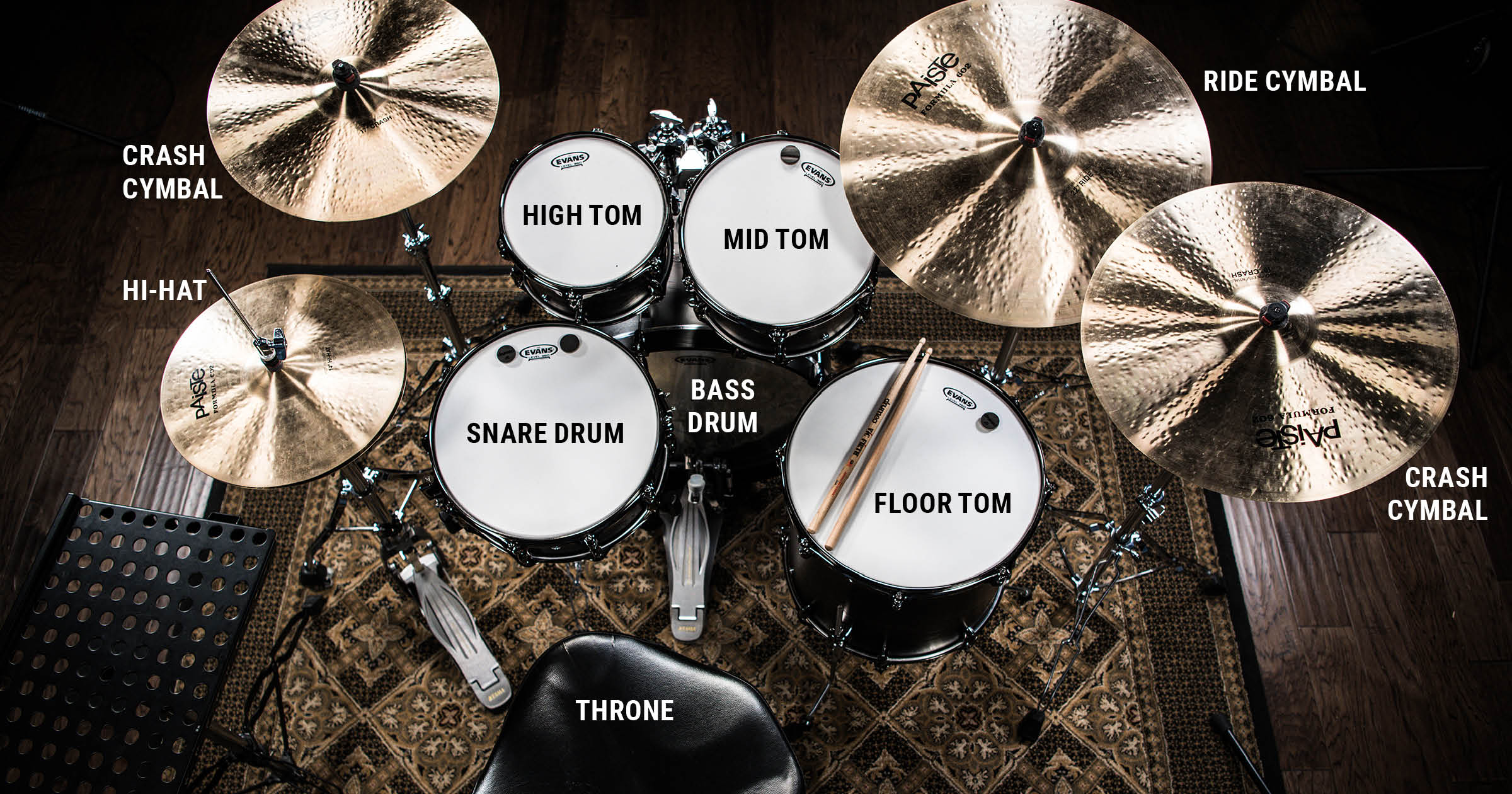
While you can get creative with how your drums are set up, make sure you can move around the kit easily. Each piece should be set up so it’s within reaching distance – you shouldn’t have to tense up your arms or legs to get there!
You can learn rudiments by practicing and memorizing a few key patterns. Like chords on a piano or guitar, rudiments are the building blocks of drumming. Learning them helps us improve our speed, stamina, and flow on the drums.
There are 40 standard drum rudiments. The core ones include the single stroke roll, the double stroke roll, the flam and the drag. Every other pattern consists of some iteration of two or three of these rudiments:
The best way to learn is to practice to a metronome until you’re able to play each one comfortably at a moderate tempo. Try alternating which hand you start with after a few minutes.
Once you know how to play rudiments, you’ll be able to tackle pretty much anything on the drums.
If you want to read drum music, you’ll come across two common forms: standard notation and tablature (tab). Both forms use notes or figures to represent each part of the drum set. The location of the note on the staff (a set of horizontal lines and spaces) tells you which drum or cymbal to play.
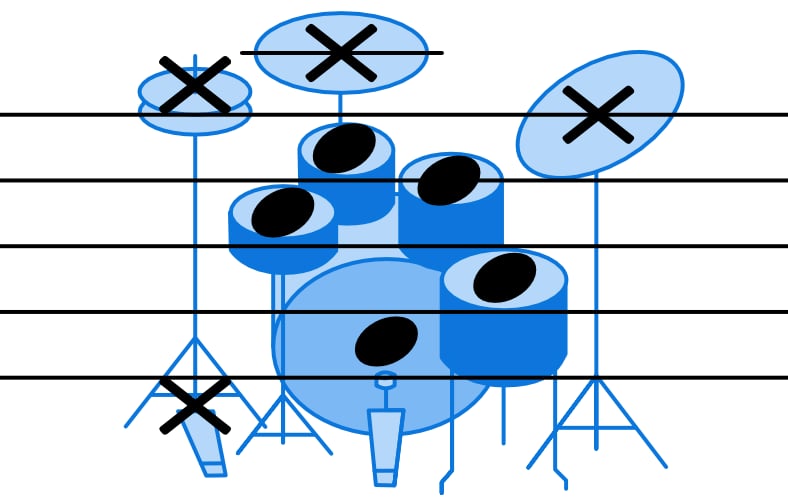
In both standard notation and tabs, an ‘x’ is typically a cymbal while an ‘o’ or round note is typically a drum.
Now that you know what to play, you need to learn when to play. Written music is divided into measures, or bars, which makes up a segment of time. Each bar has a certain number of counts (or beats) in it.
For example, most popular music is in a 4/4 time signature, which means each bar can be divided evenly into four equal segments of time. The first number tells you the number of beats in each bar, and the second number tells you the value of each beat (in this case, a beat is a quarter note, or 1/4 of a bar).
You know how to count to 4, so think of it this way: every time you count to 4, you’ve counted one bar.
Sometimes notes will fall between the beats, which you can count as ‘1 and 2 and 3 and 4 and’ (written 1 + 2 + 3 + 4 +). You can divide that even further, counting 1e+a 2e+a 3e+a 4e+a.
Now let’s take a look at a basic drum beat. Try counting out loud.

In this beat, the lowest note (bass drum) falls on the 1 and 3 while the highest note (snare drum) falls ono the 2 and 4. The ‘x’ here signifies a hi-hat cymbal, which you play through the whole bar.
You’ll also come across a ‘rest’ in drum notation, which means time you don’t play.
The following rhythm would be counted 1e+a 2e+a, where the bolded figures signify where you play and the non-bolded figures signify where you take a rest:

Feeling confused? If you want to dig deeper, check out the full guide on how to read drum music.
You can tune drums by using a drum key to loosen or tighten your drumheads. You can tune to a specific note (like a melodic instrument) or a relative pitch. Drums use a series of lugs and adjustable rods around the shell. The tighter the head, the higher the note. A looser head will give you a lower-sounding note.
To tune drums, you’ll need a drum key, which you can pick up for a few bucks (online or at your local music store) if your kit didn’t come with one.
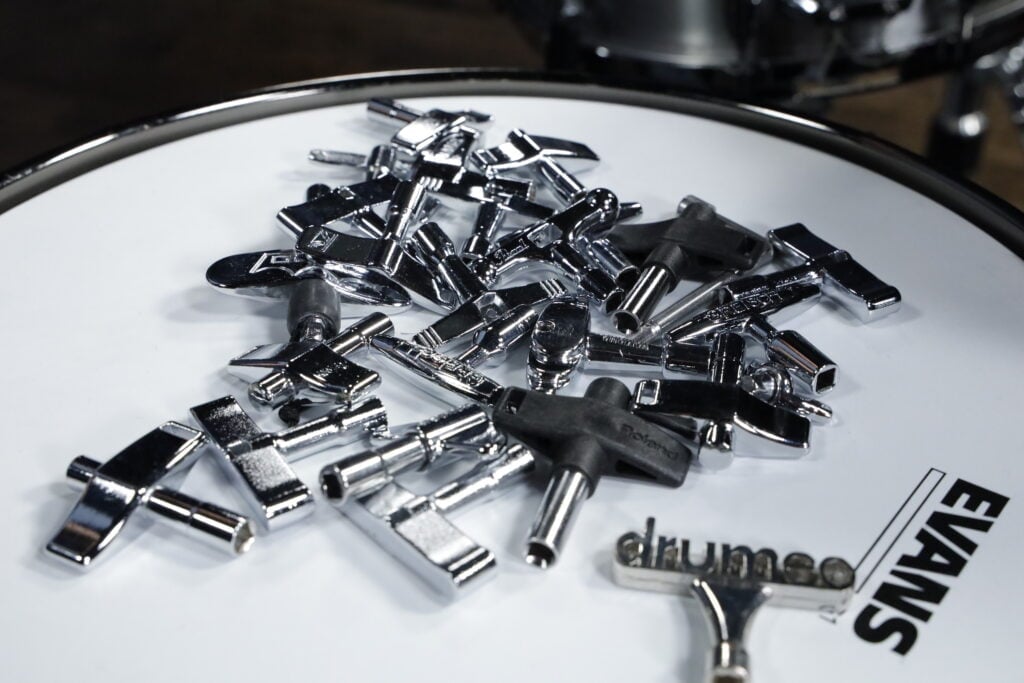
In a nutshell, here’s how to tune a drum:
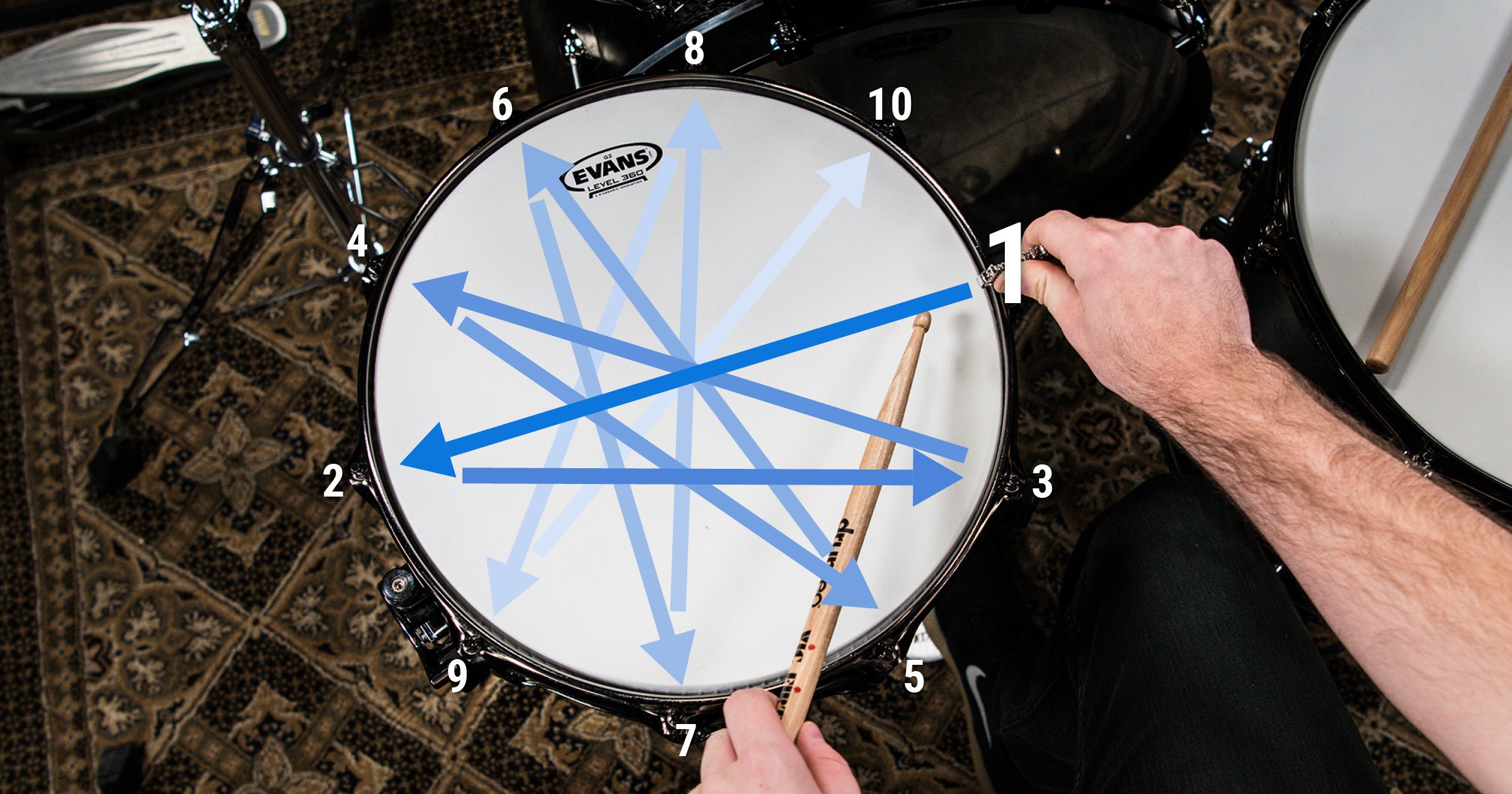
For more details, check out the complete guide on how to tune drums.
One of the best beginner drum sets is the Pearl Roadshow ($659). If you prefer an electronic kit, try the Roland TD1 ($549).
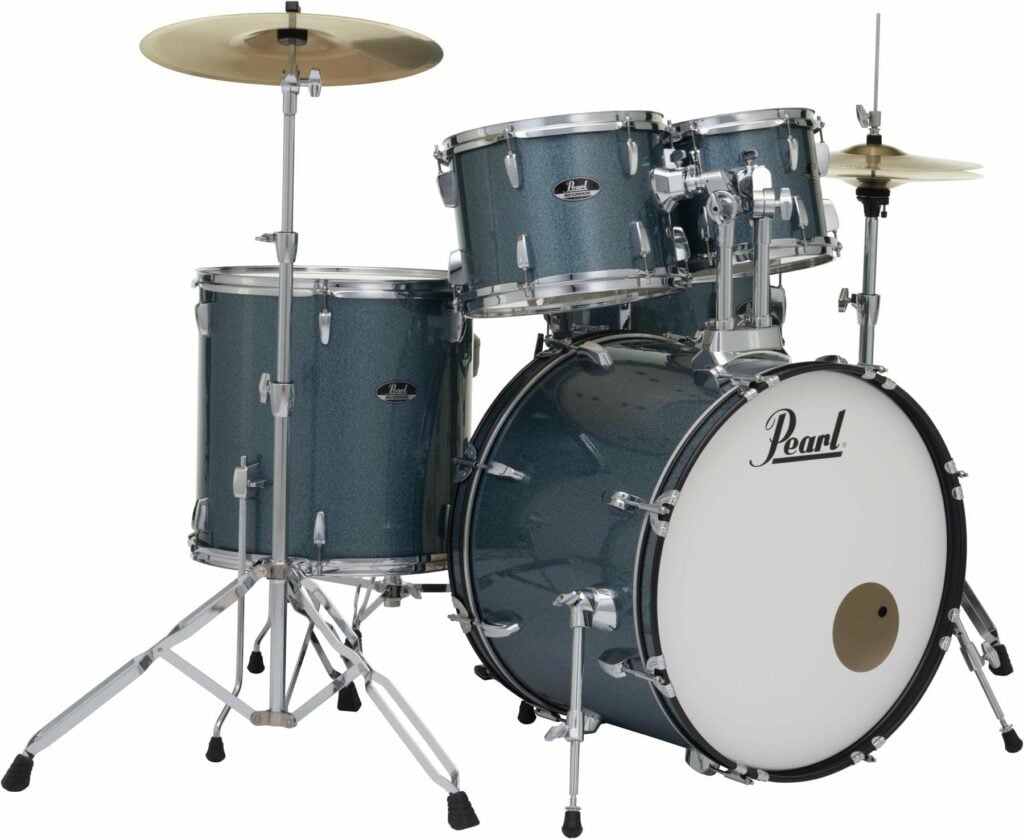
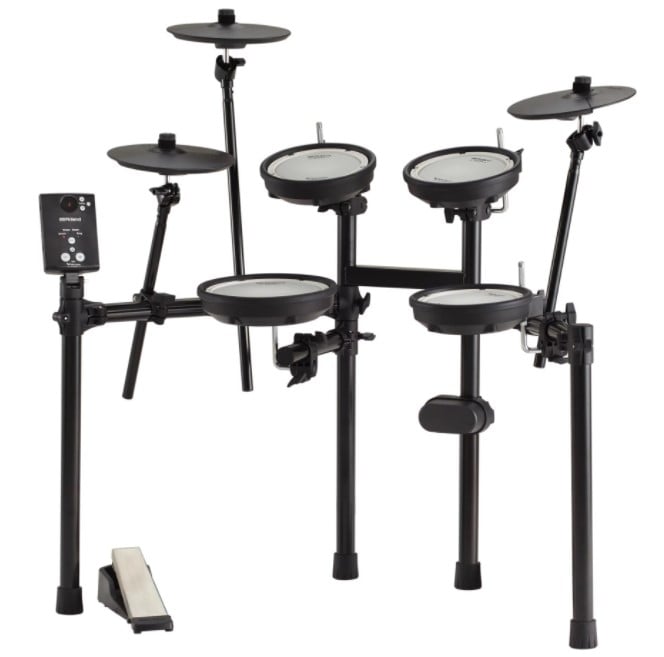
The Pearl Roadshow offers awesome bang for your buck. This updated version of the classic Pearl Export features poplar shells and comes with three toms, a bass drum and snare drum. It also comes with stands, cymbals, drumsticks, a bass drum pedal and a cymbal bag – perfect for anyone looking for an all-in-one purchase. The cymbals aren’t great, but the drums could be your ride or die for a few years or longer.
The Roland TD1-DMK is a compact and quiet electronic kit that features four mesh pads and a rubber bass drum pad alongside a rack system and three cymbal pads. With a soft rebound and decent ‘brain’ (15 built-in ‘drum kits’, 250 sounds, a metronome and more), this is a worthwhile starter kit that won’t annoy the neighbors.
We put together a whole guide on the best beginner drum sets – take a look if you want the full breakdown!
The best online drum lesson site is Drumeo. It offers thousands of video drum lessons and personalized feedback, thousands of note-for-note song transcriptions, plus direct access to your favorite drummers via courses and live Q&As.
“But you wrote this article! Of course you’re going to say Drumeo is the best.”
We may be biased, but thousands of drum students agree. Where else can you learn from Michael Jackson’s drummer or ask Styx’s Todd Sucherman for tips?
If you check out our free rudiments resource, you’ll get a taste for the practice tools you’ll find in the Drumeo members area (they let you slow down the track, loop sections and more).
Or start your free 7-day trial – and see if you like it!
Here are the 5 best songs for beginner drummers:
If that’s not enough, here’s another 20 easy songs for beginners.
What makes a song attainable for a beginner drummer? Fewer notes and a slower tempo, for two.
You can also take a more challenging song and simplify it like we did in these lessons:
You hold drumsticks by positioning the drumstick so your hand is about 2/3 down the stick, making sure your index finger isn’t sticking out and you aren’t gripping too hard.
It’s kind of like holding a pencil!
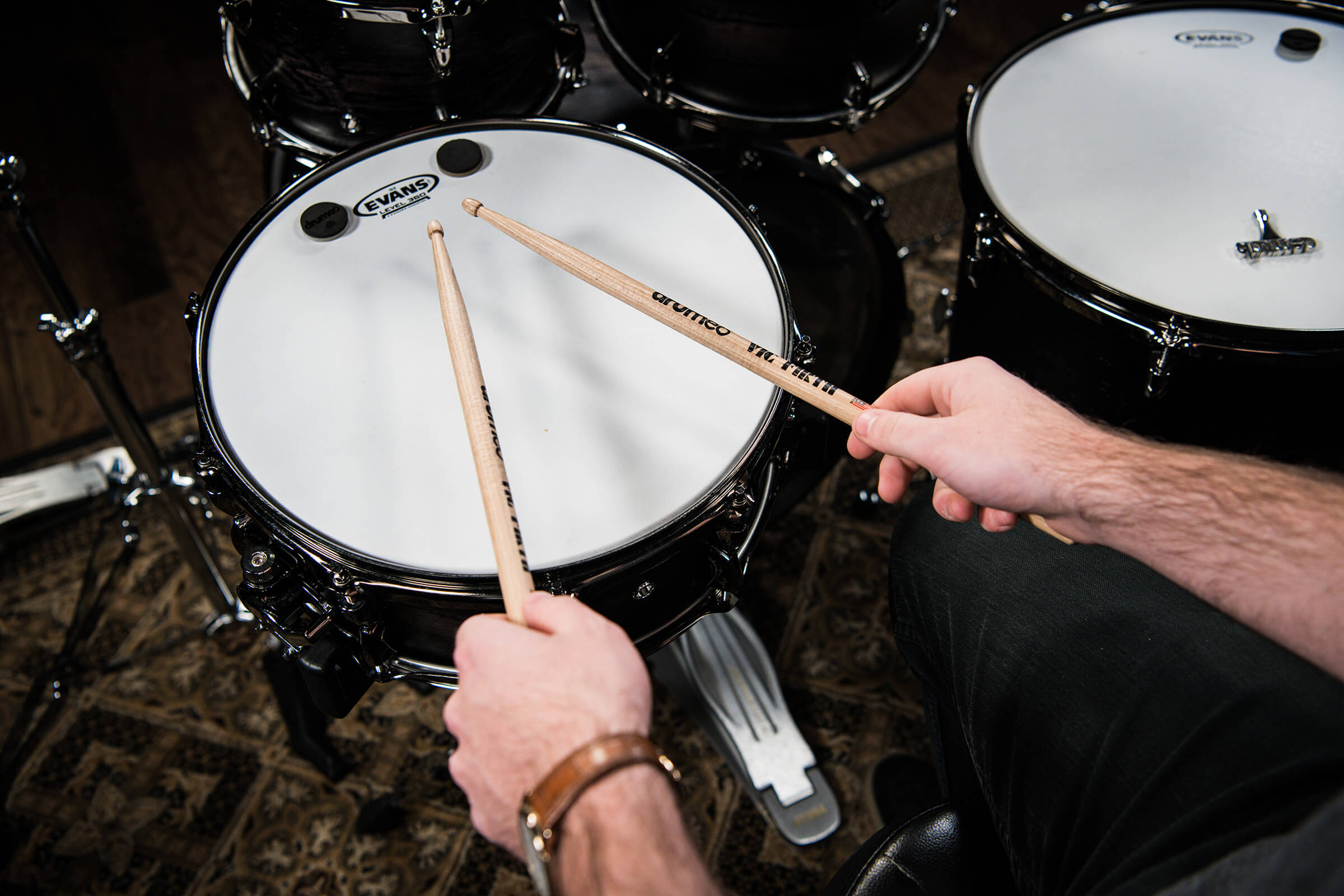
The traditional drumstick twirl comes from letting the drumstick ‘wobble’ between your index and middle finger as you rotate your wrist. With enough practice and repetition, you’ll be playing this stick trick with the best of them.
There are a ton of different stick tricks you can try. Check out these video lessons:
A full drum kit can cost anywhere from $150 to $10,000+. It all depends on what you’re looking for.
A beginner drum set costs less than $1000 – and sometimes under $500. You could get this Ludwig Questlove kit for $349, for example:
Beginner kits are made from cheaper materials and won’t sound or feel as good as a pro kit. But they’re great for kids or any new drummer who’s hesitant to shell out thousands of dollars for a hobby. You can still jam to your favorite songs and build your skills like you would on any other kit.
An intermediate drum set could set you back around $900-$1300. The Yamaha Stage Custom is a popular choice that works for many gigging and recording contexts.
A pro level kit can cost $2000, $5000, or even more. The sky’s the limit. This TAMA Starclassic is a beautiful-sounding kit with diecast hoops, but it costs $2000 just for the shells (no cymbals or stands included).
How much is a drum set? As much as you’re willing to spend!
The best way to practice drums is to give yourself enough time and repetition to build muscle memory. Do it regularly, and set goals you can work toward. If you do best with structure, take the time to build a practice routine and follow it.
Film and/or record yourself playing. It’s the best way to track your progress and self-diagnose any problems.
Whether you’re working on exercises, drum rudiments, songs or something else, learning takes time. Give yourself “permission to suck” (to quote Sarah Thawer). If you sound perfect when you practice, it means you’re not challenging yourself enough to grow and improve.
If you’re feeling like you just don’t know where to start, check out these tips for tricking yourself into practicing drums.
The best way to build drum independence is to start with just two limbs at a time, making sure you’re 100% comfortable before you add a third or fourth pattern to the mix.
Practice slowly. Give your body time to adjust to any new concepts.
Try this exercise:

Can you play it?
“Independence” is when each of your limbs can comfortably play a pattern while ignoring what the other limbs are doing. It’s the drummer’s form of multitasking, and developing independence can be a mental workout. It can take a long time to feel “free” on the drums. But it’s well worth the effort.
If you aren’t confident working on drumming independence on your own, try Independence Made Easy: a 26-week video course that’ll help you play anything you want on the drums (Drumeo members get it free).
Drums can be hard to learn because they require physical and mental multitasking. It can take some time for your body to build muscle memory.
But even kids can learn how to play drums. Don’t give up if it seems hard at first. Drumming is fun and rewarding, and with regular practice and patience, you’re going to start seeing your efforts pay off!
Here’s a list of everything you need to know before you start learning drums.
You can drum without a drum set! As long as you’re repeating the motions and locking in the muscle memory, you can learn songs and even improve your skills away from the kit.
There are a few ways to practice without drums:
There are four basic types of drumsticks:
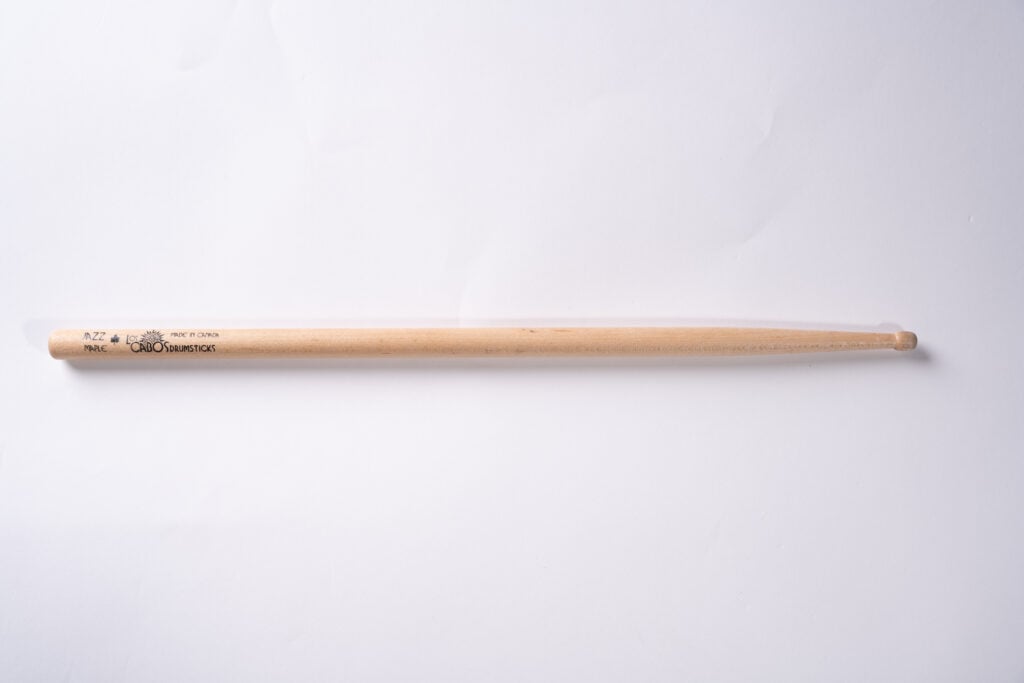
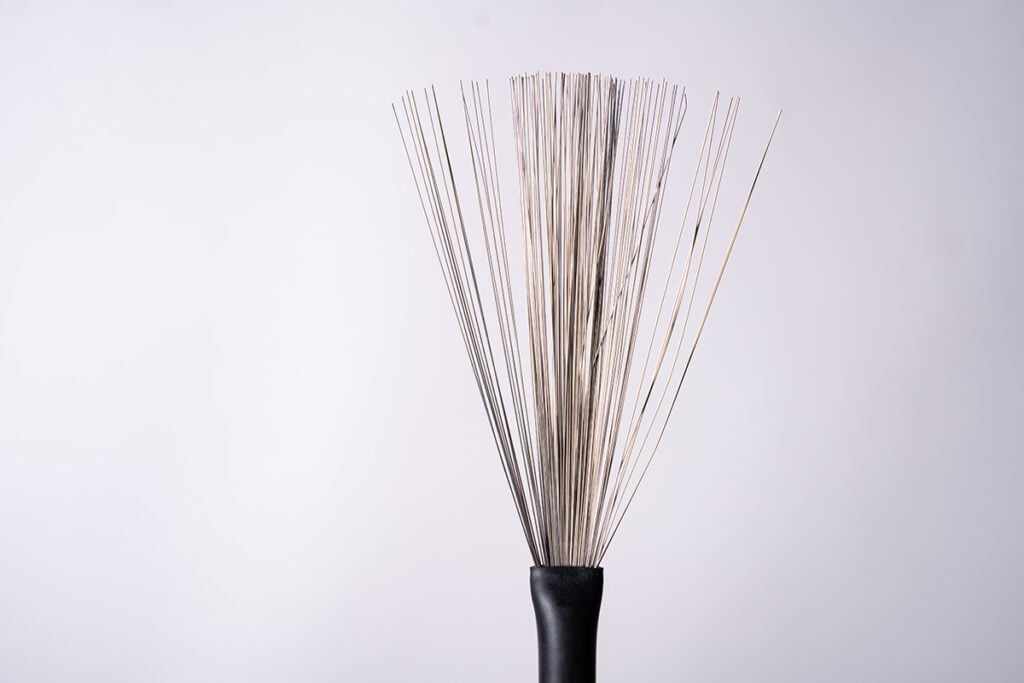
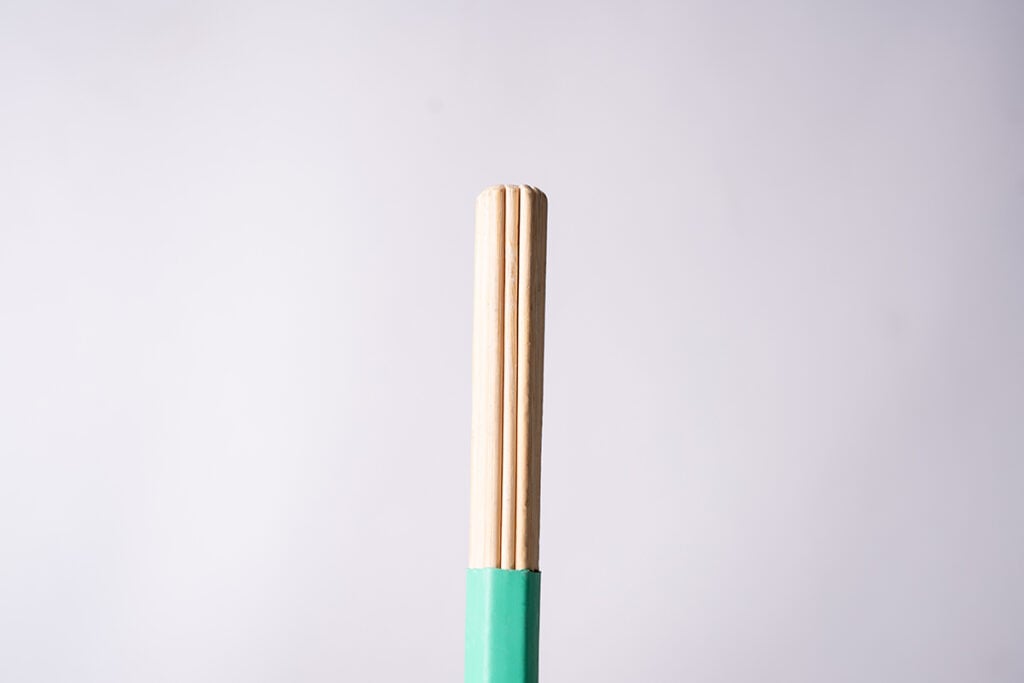
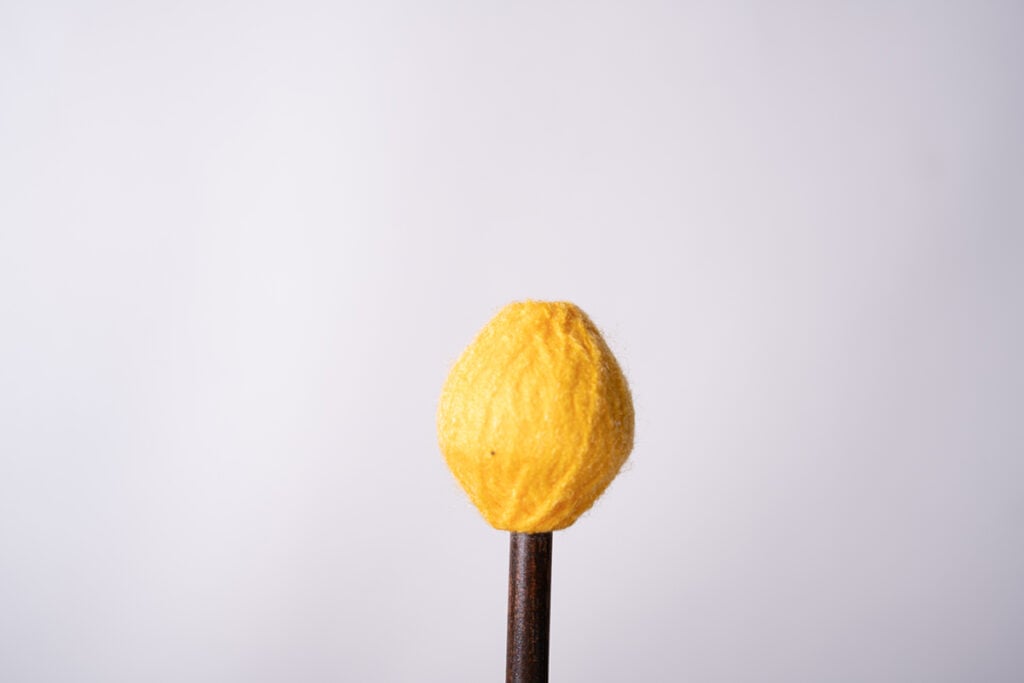
And there are five drumstick tip shapes:
(But you may find others on the market.)
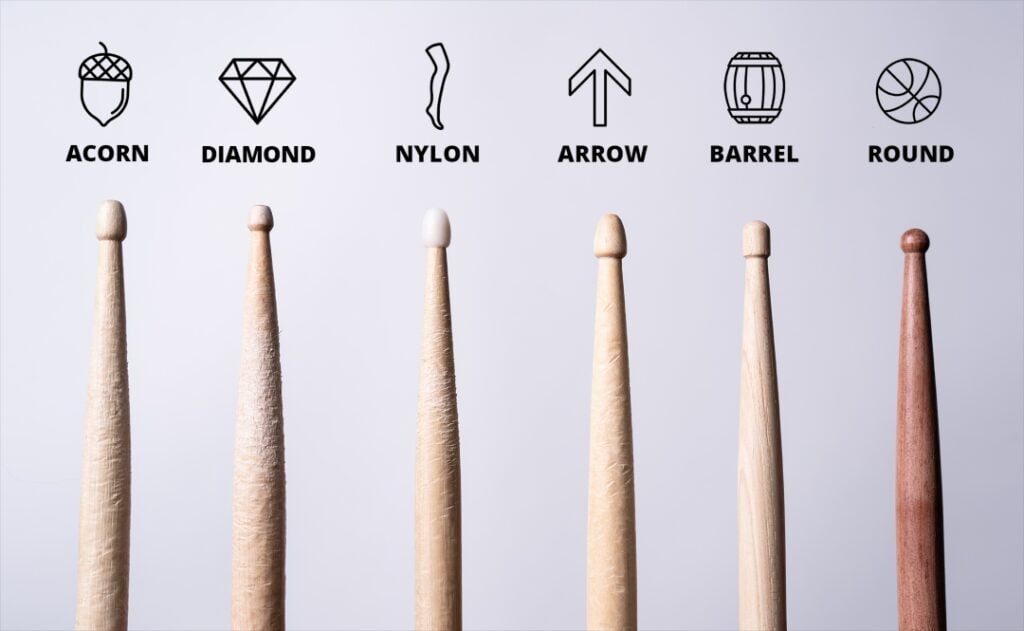
Acoustic drums are the fan favorite for most drummers, but electronic drums have quickly become a popular alternative. The top models often sound and feel similar to acoustic kits, but come with different benefits and disadvantages.
Why acoustic drums are better:
Why electronic drums are better:
Acoustic: Pearl Roadshow ($659)
Electronic: Roland TD1-DMK ($549)
It can take a few hours (or even a few days) to learn a basic beat, but it can take several months to start feeling comfortable on the drums. It takes time to train your body’s coordination.
It might take two years of consistent practice to reach a level where you’re really feeling good and able to play a ton of material well. But everyone is on their own journey.
Are you able to play drums every day? Or do you have 30 minutes to practice once a week? There is no right or wrong answer – learning drums is what you make of it.
Here are 5 tips to build a practice routine on the drums:
Every drummer has their own routine preferences. Don’t forget to have fun, and if you aren’t seeing improvement, make sure you’re challenging yourself enough.
Here are 5 ways to improve your speed on the drums:
Have you seen El Estepario Siberiano on social media? He’s one of the fastest drummers around right now. If your dream is to reach his speed, check out his free course, Fastest Way To Get Faster. You’ll start playing faster after working through just 10 lessons!
The best ways to join a band – or get session work as a drummer – is to share your playing on social media, develop your skills in different styles, and try to meet other musicians online or at gigs.
Yes: acoustic drums are loud! You should always wear ear protection when you’re playing drums or standing next to a drum kit.
The cymbals and snare drum are typically the loudest parts of the drum kit. You should get headphones or earplugs to help deal with the noise. As a drummer, your hearing is extremely important: protect it!
If you want to practice drums quietly, you can always get an electronic drum set instead.
The best way to get better at drums is to find a good teacher – and good online content – to keep you motivated and help you level up.
Listening to different genres will also help you become a more well-rounded drummer, and learning how other drummers play and write will give you a foundation on which you can develop your own sound.
Drumming is great exercise! It’s awesome for cardio, keeps your limbs moving and blood pumping, and is good for mental health. Drumming keeps your brain sharp, too.
Edited by Sam Landa, Content Marketing Manager at Drumeo
Drumeo Team - We're professional, award-winning drummers and drum teachers, coaches, recording artists, and content specialists who are passionate about drums and helping drummers around the world. This post was written and/or edited by Brandon Toews, Jared Falk, Dave Atkinson, or another pro on our team (which has a combined 1000+ years of drumming experience). Are you looking for inspiration, education, and support to take your playing to the next level? Join the Drumeo community today!


By signing up you’ll also receive our ongoing free lessons and special offers. Don’t worry, we value your privacy and you can unsubscribe at any time.
We use cookies for traffic data and advertising. Cookie Policy »
/marketing/drumeo/lead-gen/easy-rudiments/blog-m.png)
Grab a FREE E-Book with the 15 Rudiments you need to know (and how to learn them quickly)
Enter your email and we’ll send your book instantly.
Don’t worry, we value your privacy
and you can unsubscribe at any time.